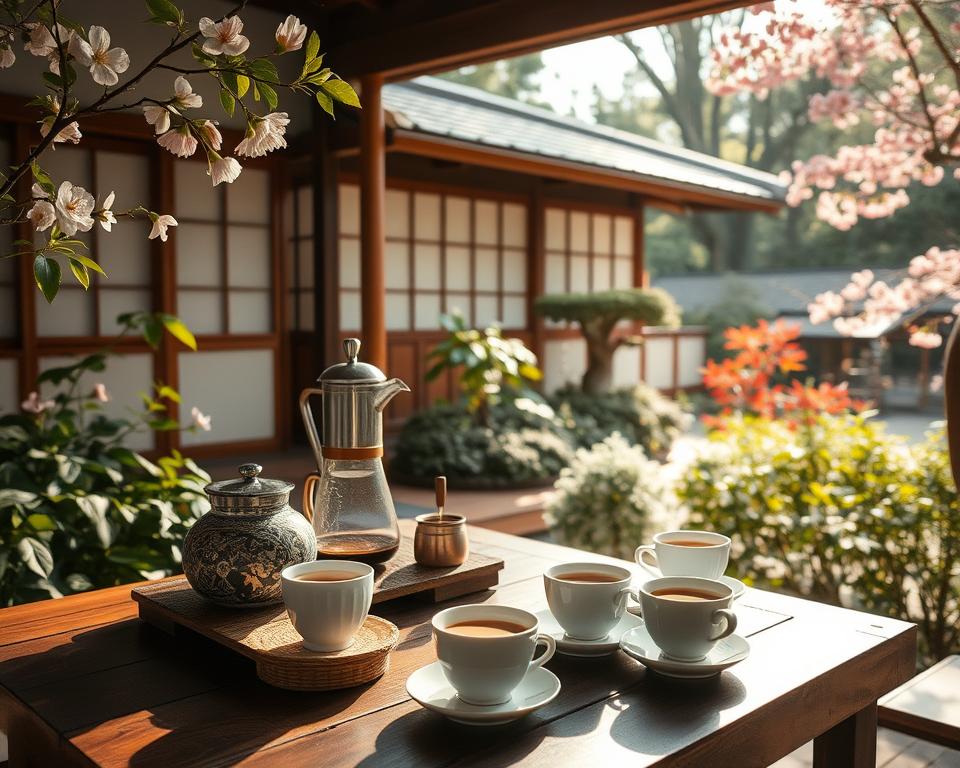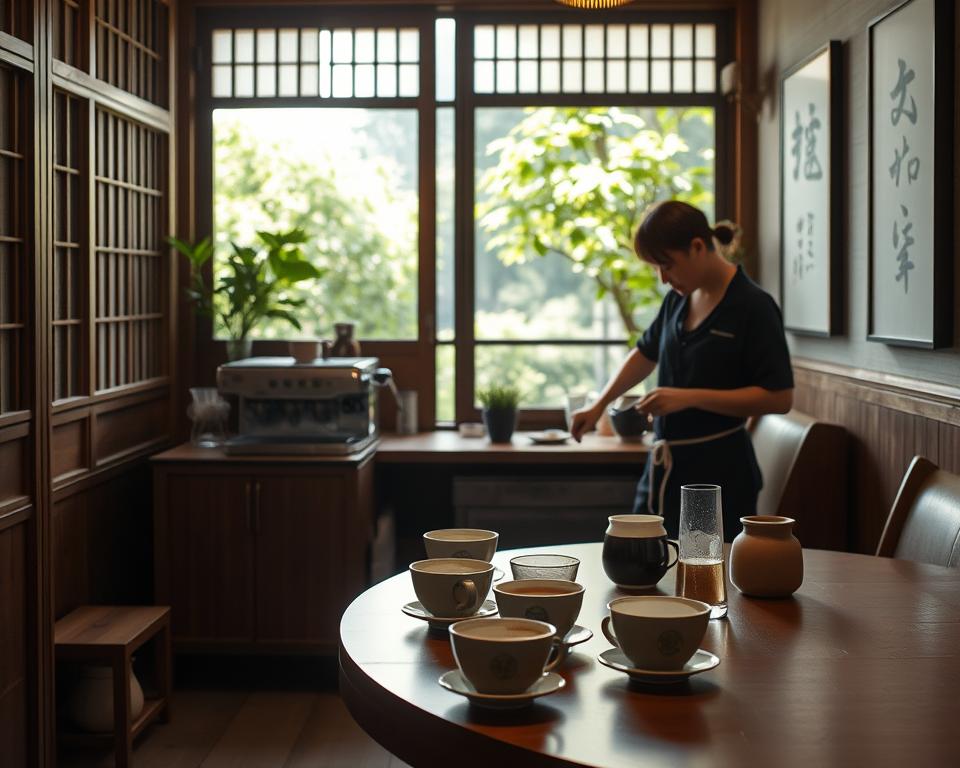Japanese coffee culture is a captivating mix of old and new, with a deep history and a vibrant coffee scene. It has become famous globally, known for its unique blend of traditional brewing methods and modern coffee shops. Japan is now a hotspot for coffee lovers, offering everything from traditional kissaten to cutting-edge third-wave coffee spots.
At the core of Japanese coffee culture are its traditional brewing techniques, perfected over time to create a distinct taste. Introduced to Japan in the 18th century by Dutch traders, coffee has become a staple, with the country now ranking among the top coffee consumers worldwide. The preference for high-quality beans and unique brewing methods is evident in Japan’s coffee culture.
The Japanese coffee culture is more than just the coffee; it’s about the experience. From the cozy kissaten to the sleek modern coffee shops, Japan caters to all tastes. With its rich history, unique brewing methods, and booming coffee industry, Japanese coffee culture is a topic of growing interest globally.
Key Takeaways
- Japanese coffee culture is a unique blend of traditional and modern elements.
- The country has a rich history of coffee consumption, dating back to the 18th century.
- Traditional coffee brewing methods are an integral part of japanese coffee culture.
- Japan is one of the largest consumers of coffee globally, with a strong preference for high-quality coffee beans.
- The country’s coffee culture is shaped by its history, with a unique blend of traditional and modern elements.
- Japanese coffee culture offers a wide range of coffee experiences, from traditional kissaten to modern specialty coffee shops.
- The country’s coffee industry is thriving, with a growing number of coffee shops and cafes.
A Brief History of Coffee in Japan
Coffee’s arrival in Japan dates back to the 17th century, brought by Dutch traders. Yet, it wasn’t until the late 19th century, during the Meiji Restoration, that it started to gain traction. This period kickstarted Japan’s coffee history, embedding it deeply into the country’s coffee culture in Japan.
The evolution of coffee culture in Japan was driven by several factors. New brewing techniques and coffee bean varieties were introduced, fueling the growing demand. The emergence of the first coffee shops created a unique social hub where people could come together to enjoy their coffee.
Key milestones in Japan coffee history include the launch of canned coffee in the 1960s and the advent of specialty coffee chains in the 1980s. Today, Japan stands out as a global leader in coffee revenue, with a vibrant coffee culture in Japan that continues to grow and innovate.
The influence of global coffee trends has significantly shaped Japan’s coffee industry. New brewing methods and coffee beans have been introduced, making Japan a hotspot for coffee aficionados. This has led to a proliferation of coffee shops and specialty coffee roasters, catering to a wide array of tastes and preferences.
| Year | Event | Description |
|---|---|---|
| 1600s | Coffee introduction | Coffee was first introduced to Japan by Dutch traders. |
| 1800s | Meiji Restoration | Coffee gained popularity during the Meiji Restoration. |
| 1960s | Canned coffee launch | Canned coffee was launched in Japan, increasing its market presence. |
The Unique Japanese Coffee Preparation Techniques
Japanese coffee culture is celebrated for its innovative preparation methods, now loved globally. Techniques like pour-over and siphon brewing are highly esteemed in Japan. The country is also famous for its specialty coffee, known for its high quality and unique flavors.
Pour Over Coffee: The Pour-Over Trend
Pour-over coffee is a favorite in Japan. It involves slowly pouring hot water over ground coffee beans in a filter. This method yields a nuanced and flavorful cup of coffee.
Siphon Brewing: A Theater of Coffee
Siphon brewing, or vacuum brewing, is a theatrical process. It uses a two-chamber apparatus to brew coffee. This method produces a smooth, full-bodied cup with a distinct flavor.
Japanese Iced Coffee: Refreshing Innovation
Japanese iced coffee is a refreshing innovation. It involves dripping hot coffee over ice, creating a unique and delicious flavor. This method is ideal for hot summer days and is a hit among coffee lovers in Japan.
- Pour-over brewing
- Siphon brewing
- Japanese iced coffee
- Cold brew coffee
- Kyoto drip method
These techniques are highly valued in Japan. They are used to create a wide range of delicious and unique coffee drinks.
| Coffee Preparation Technique | Description |
|---|---|
| Pour-over brewing | A manual brewing method that involves slowly pouring hot water over ground coffee beans in a filter. |
| Siphon brewing | A theatrical process that involves using a two-chamber apparatus to brew coffee, resulting in a smooth and full-bodied cup. |
| Japanese iced coffee | A refreshing innovation that involves dripping hot coffee over ice, creating a unique and delicious flavor profile. |
Coffee Shops: The Heart of Japanese Coffee Culture
Coffee shops are a vital part of Japanese coffee culture, offering a unique and inviting space for coffee lovers. From specialty coffee shops to traditional kissaten, each venue provides a distinct experience. Japanese coffee shops have grown to meet a variety of tastes and preferences.
The roots of Japanese coffee culture are deeply embedded in tradition. Coffee traditions in Japan trace back to the late 19th century. The first coffee shop, Kahiichakan, opened in Tokyo in 1888, starting Japan’s coffee journey. Today, coffee shops are ubiquitous in Japanese cities, with well-known chains like Doutor and Tully’s Coffee Japan, alongside independent gems like Onibus Coffee and Café Bon.
Specialty Coffee Shops
In Japan, specialty coffee shops emphasize high-quality coffee beans and innovative brewing techniques. These establishments often partner with local roasters, such as Ueshima Coffee Company, Japan’s leading coffee brand. Onibus Coffee and Café Bon are notable examples, offering a variety of coffee drinks and a warm ambiance.
Traditional Kissaten
Traditional kissaten, or Japanese coffee houses, evoke a nostalgic and retro vibe. They serve coffee through traditional methods, like hand-brewing, and provide a selection of coffee drinks and snacks. Kissaten coffee shops are deeply ingrained in Japanese culture, with many dating back to the Showa Era (1926-1989).
The Role of Coffee in Daily Life
Coffee is deeply ingrained in Japan’s daily life, serving as a morning staple for many. The coffee culture in Japan is distinct, marked by a serene morning ritual. It offers a moment of calm, with coffee providing comfort and tranquility.
Socializing over coffee is a common practice, with friends and colleagues gathering at coffee shops. Here, they engage in conversations and discuss business. The Japanese coffee rituals are central to these gatherings, with coffee shops providing a peaceful setting and a variety of coffee choices.
Some notable trends in coffee culture in Japan include:
- Increased consumption of specialty coffee
- Growing popularity of independent coffee shops
- Rise of coffee vending machines
Japan ranks third globally in coffee consumption, with each person consuming about 4.5 kg annually. The Japanese coffee rituals and coffee culture in Japan are set to evolve further, with a focus on sustainability and quality.

Coffee shops in Japan are more than just places for a quick coffee. They are community centers where people socialize, work, and unwind. The coffee culture in Japan is a captivating part of Japanese society, constantly evolving.
| Coffee Consumption Trends | Japan | Global |
|---|---|---|
| Average consumption per person | 4.5 kg | 2.5 kg |
| Rank in global coffee consumption | 3rd |
Japanese Coffee Beans: Regional Differences and Quality
Japanese specialty coffee is celebrated for its distinct flavors and regional nuances. Prefectures like Kagoshima, Okinawa, and Miyazaki each contribute unique taste profiles. These differences stem from climate, soil, and processing techniques.
The Japanese coffee industry places a high value on quality. Coffee beans are carefully selected and processed to enhance flavor and aroma. This attention to detail makes Japanese coffee beans more expensive, with prices between $15 and $25 per pound for premium varieties.
Japanese specialty coffee is known for several key characteristics:
- High-quality Arabica beans
- Unique flavor profiles shaped by regional factors
- Rigorous quality control measures
- High demand for specialty coffee in Japan
Japan imports about 85% of its coffee, mainly from Brazil, Colombia, and Vietnam. Yet, there’s a rising interest in specialty coffee, focusing on unique and high-quality flavors. This shift is driven by the growing popularity of coffee traditions in Japan, with consumers seeking out premium coffee experiences.
Over 90% of Japanese baristas have formal training, highlighting the industry’s emphasis on precision and technique. This dedication to quality has fueled the growth of Japan’s specialty coffee market. It’s expected to reach ¥230 billion (around $2.1 billion) by 2025.
| Prefecture | Flavor Profile | Quality |
|---|---|---|
| Kagoshima | Rich, full-bodied | High |
| Okinawa | Light, fruity | Medium |
| Miyazaki | Smooth, balanced | High |
Influential Japanese Coffee Brands and Roasters
The Japanese coffee scene is celebrated for its distinct and premium coffee brands and roasters. UCC, founded in 1933, made history by introducing the first canned coffee in 1969. Today, UCC operates various café brands, each offering a unique coffee experience. This diversity highlights the richness of Japanese specialty coffee.
Suntory, with annual revenues of 21 billion dollars, is famous for its BOSS coffee brand. Doutor, boasting over 1,300 cafés in Japan, has also expanded to Taiwan, Malaysia, and Singapore. These brands have significantly contributed to Japanese coffee culture’s growth. They focus on quality and innovation.
Some notable Japanese coffee brands and roasters include:
- UCC: Known for its high-quality coffee and innovative products
- Suntory: Famous for its BOSS coffee brand and flash brewing process
- Doutor: Recognized for its open flame roasting and diverse coffee offerings
- Sapporo Coffee Kan: Utilizes Sumiyaki (Charcoal) Coffee Roasting for a distinctive flavor
- Komeda Coffee: Focuses on creating a “second living room” atmosphere and high-quality coffee
These brands, among others, have shaped the Japanese coffee culture. They continue to innovate and influence the industry. This makes Japanese specialty coffee a highly sought-after experience globally.
| Brand | Established | Notable Features |
|---|---|---|
| UCC | 1933 | Introduced world’s first canned coffee |
| Suntory | 1899 | BOSS coffee brand, flash brewing process |
| Doutor | 1980s | Open flame roasting, diverse coffee offerings |
The Art and Aesthetics of Japanese Coffee
Japanese coffee culture is a blend of tradition and modernity, with a focus on aesthetics. The visual presentation of coffee is key in japanese coffee culture. It features beautifully crafted coffee drinks and exquisite presentation. The art of coffee making in Japan emphasizes simplicity, elegance, and detail.
The coffee traditions in Japan are highly valued. They aim to create a unique and visually appealing experience. Minimalist coffee shop design has become popular, with clean lines and simple decor. This reflects in many modern Japanese coffee shops, with sleek and minimalist interiors.
- Minimalist decor
- Simple, elegant design
- Focus on high-quality coffee beans
- Exquisite presentation of coffee drinks
These elements combine to create a unique and captivating experience. It showcases the art and aesthetics of japanese coffee.
Exploring Coffee Festivals and Events in Japan
Japan’s coffee culture is celebrated through numerous festivals and events each year. These gatherings unite coffee lovers, local roasters, and global brands. They honor Japan’s coffee heritage, which began with the opening of Tokyo’s first coffee shop in 1888.
Coffee festivals like the Tokyo Coffee Festival and the Osaka Coffee Festival draw thousands. They showcase local coffee shops, roasters, and suppliers. Attendees can sample diverse coffee blends, learn brewing techniques, and connect with the coffee community. These events also spotlight Japan’s coffee culture, from traditional kissaten to modern specialty shops.
Some notable coffee festivals and events in Japan include:
- Tokyo Coffee Festival: A biannual event featuring local and international coffee brands.
- Osaka Coffee Festival: A celebration of coffee, music, and food.
- Sendai Coffee FES: A free admission event showcasing local coffee shops and roasters.

Beyond festivals, Japan hosts coffee competitions like the Japanese Barista Championship. This event brings together skilled baristas to display their artistry. It showcases Japan’s dedication to coffee and its traditions.
The Future of Japanese Coffee Culture
The Japanese coffee industry is on the rise, with a bright future ahead. New trends and innovations are transforming the scene. Younger people are driving the demand for specialty coffee and creative brewing methods. Sustainability is also a major focus, with efforts to reduce waste and use eco-friendly packaging.
Japanese specialty coffee’s popularity is set to soar, with the younger crowd leading the way. This shift is reviving interest in traditional Japanese coffee culture. They seek out the unique charm of iconic kissaten cafes. This blend of heritage and modern trends promises a dynamic future for the industry.
The Japanese coffee culture is set to evolve, balancing tradition and innovation. As it continues to attract both local and global attention, we can expect more exciting developments. This vibrant coffee landscape is sure to captivate audiences worldwide.
FAQ
What is the history of coffee in Japan?
What are the unique Japanese coffee preparation techniques?
What role do coffee shops play in Japanese coffee culture?
How is coffee integrated into daily life in Japan?
What are the unique characteristics of Japanese coffee beans?
What are some influential Japanese coffee brands and roasters?
How do the art and aesthetics of Japanese coffee influence the culture?
What are some of the notable coffee festivals and events in Japan?
What are the emerging trends and innovations in Japanese coffee culture?

Robert Lowe is a writer at WyNeeds, where he shares his expertise and passion for coffee. With a deep appreciation for the art of brewing, he explores various coffee techniques, bean origins, and industry innovations. His engaging and informative content helps coffee lovers of all levels discover new flavors, refine their brewing skills, and stay updated on the latest trends in the coffee world.

